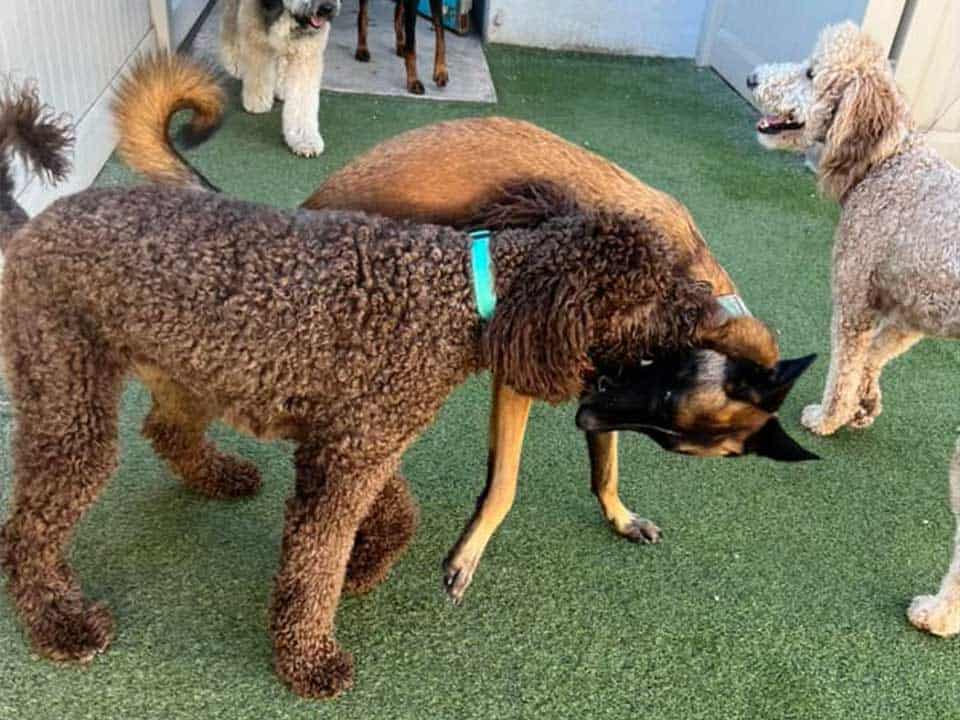What is Humping?
Humping. It’s a little funny to talk about and a little embarrassing if you witness the behavior in your own dog. It’s a common behavior in dogs, especially in group settings like dog daycare. It’s often misperceived as a sexual behavior.


Why Do Dogs Hump?
There are many reasons why a dog might exhibit mounting or humping behavior.
Excitement or over-stimulation
Dogs release their excitement in many ways. They often bark, whine, or jump to express themselves and their excitement. When feeling overwhelmed or aroused, dogs need to release that stress in some way. This overstimulation can result in humping. Dogs with pent-up energy can also use mounting as a release. Make sure your pup has plenty of exercise and mental stimulation.
Playing
Humping is a fairly natural play behavior. Balanced humping is acceptable and is when both dogs taking turns and only hump for a short while. However, if one dog is not tolerant of this behavior then intervention is necessary. There are typically clear signals this is occurring. And, this is why we have a Pet Care Specialist monitoring all play at all times.
Medical issues
It is possible (but rare) that dogs hump due to a medical issue. It can signal prostate issues in male dogs, skin infections, or urinary tract infections. Always check with your veterinarian if you suspect any of these problems.
Reproductive Urges
If the mounter is not spayed or neutered, the mounting may be sexual. Also, female dogs mount too. Just like male dogs, female dogs hump out of excitement, over arousal, stress, play and frustration. Humping in dogs can occur during times of play, stress, anxiety, excitement, boredom or frustration. These are things that ALL dogs experience, not just male dogs!
Lack of Socialization
Oftentimes, we see dogs mounting that have little to no experience in a group play setting. Because mounting is a natural behavior and it feels good, many dogs will integrate it into their play style. Especially if they’ve never been corrected by another dog or person. Most dogs are great at reading signals from other dogs and will learn canine social manners quickly.


Solutions to Humping
So if humping is natural behavior, why do we need to intervene? For safety reasons, it is best to stop the behavior quickly to avoid any potential conflicts. Immediate intervention is crucial if the mounter is not reading another dog’s signals to be left alone.
Early intervention
Early intervention prevents dogs from becoming fixated on the behavior. Fixation can lead to stress and elevated levels of arousal. Mounting does not necessarily mean that a particular dog is trying to be dominant. It’s problematic if the mounting precedes behaviors like mounting the neck and shoulder area, or displaying stiff body language. These behaviors are aggressive and require immediate intervention.
Redirection and positive reinforcement
These are the best tools we have for dealing with mounting. Everyone wins if we can shift a dog’s focus from humping to something more rewarding and fun! If the mounter is fixated or overstimulated, a short break will lower arousal levels.
Spray/Neuter
Spraying or neutering may curb sexually motivated mounting. Bear in mind that recent research indicates spaying/neutering certain breeds at young ages can have health implications. If your dog is young, behavior training is recommended until neutering is safe. Consult your vet if you are unsure of the right time to neuter or spay your pet. In extreme cases, dogs may need to take a temporary break from daycare to keep everyone safe.
Training
Training is also a great way to manage humping (and really any) unwanted behavior! A strong recall or command is very helpful when working with dogs prone to mounting. Strong recalls include listening to their name or a “come” or “off” command. Working on regulating a dog’s excitement level can also help manage this behavior. For example, training a dog to sit when visitors arrive prepares the dog for a more appropriate arousal level.
Conclusion
All of these tools help us as handlers manage unwanted behaviors like mounting.
Dogs will be dogs! The Happy Pets team is here to answer questions regarding dog behavior and how it affects group play. We are trained on many aspects of behavior to keep all the dogs in our care safe and happy. We love them like they’re our own!
Sources:
